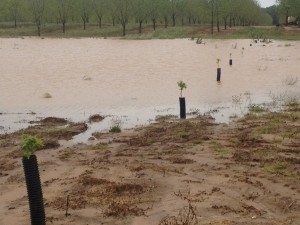All the rain we’ve seen over the last few weeks has left many orchards with trees in standing water. How might this affect the trees? The pecan tree’s native environment is found along river-bottoms, which tend to have high water tables and a high potential for flooding. Yet, oddly, the pecan tree is sensitive to poorly drained soils. So, how does a pecan tree thrive in a river-bottom? The key is soil drainage.
The effect of flooding on pecan trees depends on when the trees are flooded and how long they remain under water. Rainfall in the pecan’s native range is usually higher in winter and spring. Flooding during dormancy basically has no effect on the tree. If flooding occurs at bud-break, root growth, leaf expansion, leaf area, photosynthesis, and leaf N are reduced, but with good soil drainage, trees can recover quickly. Flooding in summer and fall can cause leaf scorching and defoliation. While flooding limits movement of nutrients to the leaves, it does not stop root absorption as long as the roots are functional. If the trees remain under water for extended periods (several weeks), the root depth may remain so shallow that the trees are easily blown over by wind or the trees simply decline as a result of root rot and eventually die from a lack of oxygen.
So, how long can pecan trees remain under water with no ill effects? Photosynthesis will be reduced following 5 days of flooding. If trees remain flooded for 35 days or more, they may lose up to 30% of the root system. Young trees will be more sensitive because they have less root to lose. Both of these factors will have significant effects on the tree’s growth, production, and survival. It usually takes a pecan tree about as long to recover to its normal functioning as the amount of time it remains flooded. So a tree flooded for 30 days will take about another month to get back to normal; however, its growth and/or production will likely be reduced for the year. In its natural habitat along bottomland ridges, the flooded soil drains relatively rapidly. Just as in the bottomland forest, the key to the tree’s recovery in the orchard depends on how fast the soil drains the water the tree is standing in.


